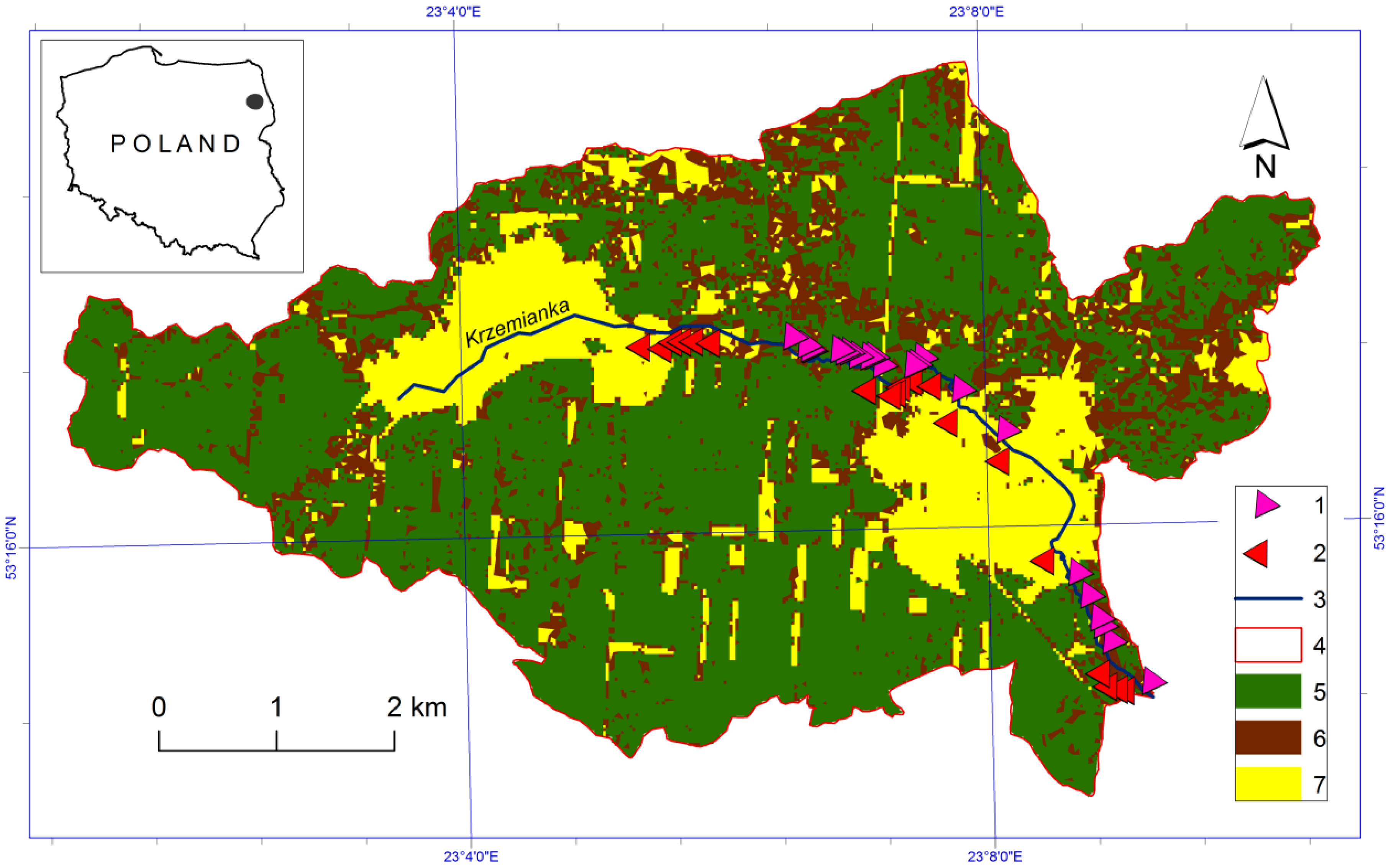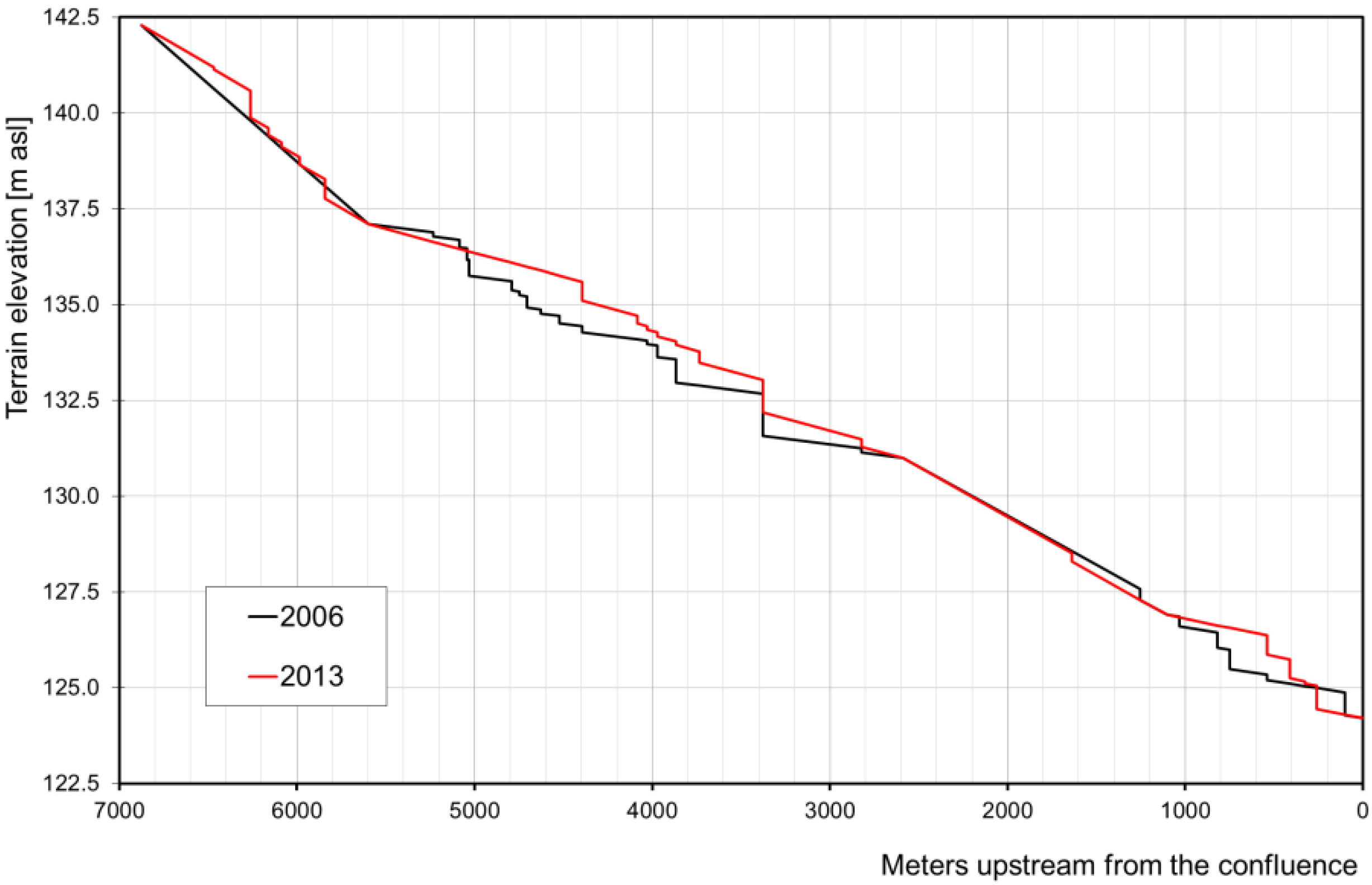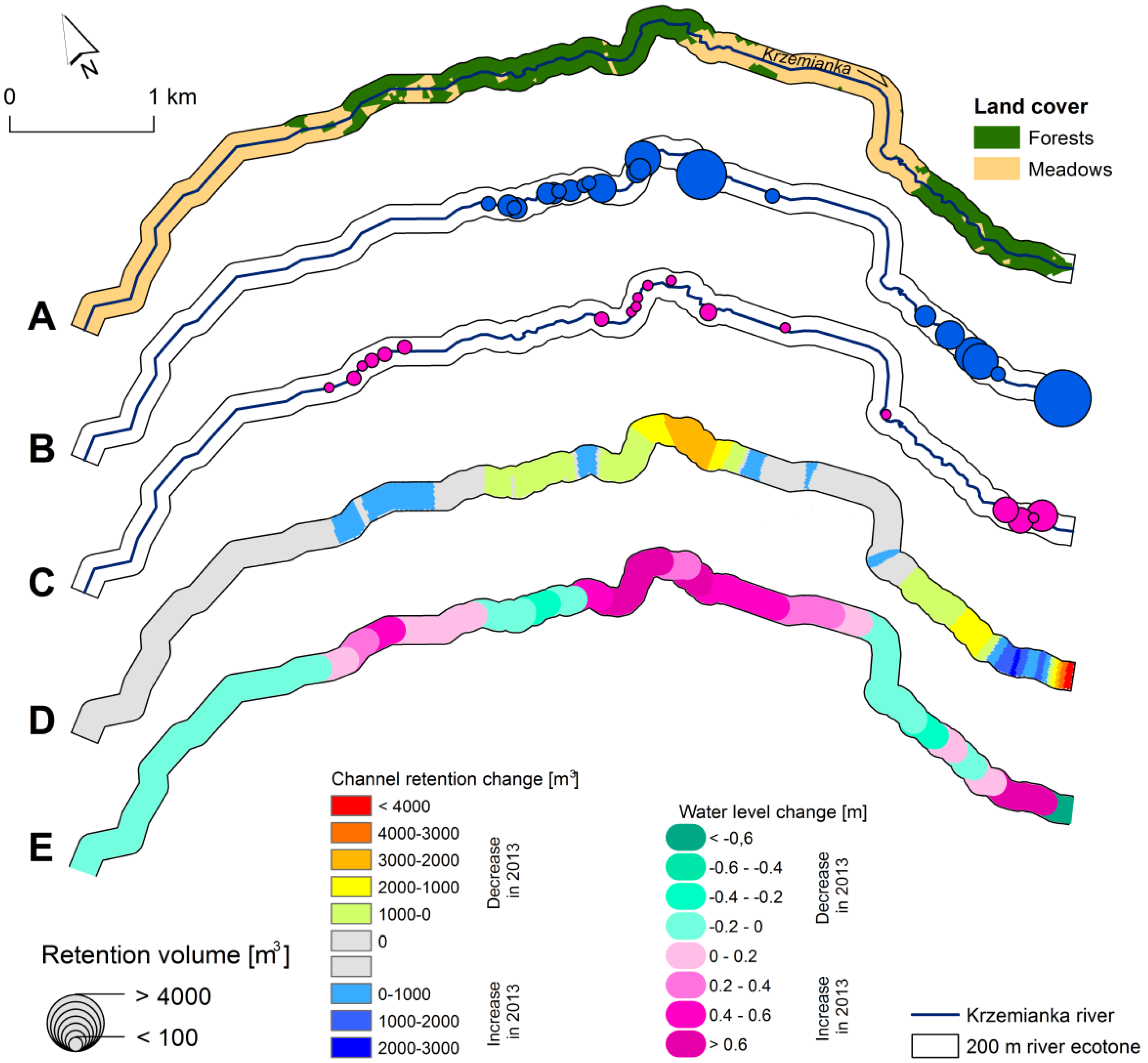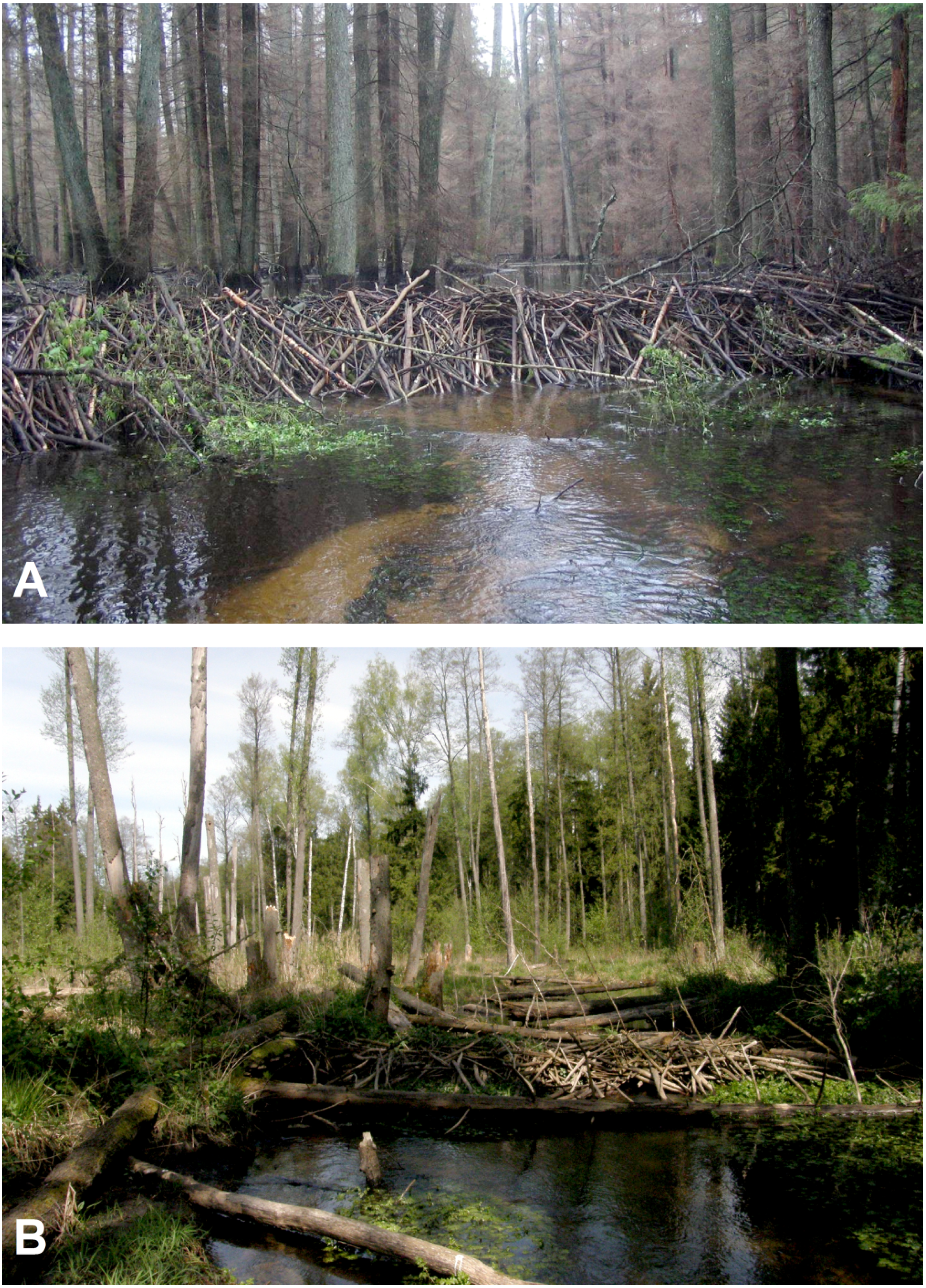Spatial and Temporal Variability of Channel Retention in a Lowland Temperate Forest Stream Settled by European Beaver (Castor fiber)
Abstract
:1. Introduction
2. Materials and Methods
2.1. Study Area
2.2. Field Investigation

3. Results
| Statistic | 2006 | 2013 |
|---|---|---|
| No. of beaver ponds | 22 | 19 |
| Total volume of ponds (m3) | 15,000 | 7000 |
| Total damming height of the cascade (m) | 6.6 | 5.6 |
| Avg. damming height (m) | 0.3 | 0.3 |
| Max. damming height of a single dam (m) | 1.1 | 0.9 |
| Avg. volume of ponds (m3) | 680 | 370 |
| Max. volume of a single pond (m3) | 4550 | 2000 |
| Avg. area of beaver ponds (m2) | 890 | 320 |
| Total area of beaver ponds (m2) | 46,300 | 6080 |
| Max. area of beaver pond (m2) | 13,000 | 350 |


4. Discussion

5. Conclusions
Acknowledgments
Author Contributions
Conflicts of Interest
References and Note
- Boczoń, A.; Wróbel, M.; Syniaiev, V. The Impact of Beaver Ponds on Tree Stand in a River Valley. J. Water Land Dev. 2009, 13a, 313–327. [Google Scholar]
- Collen, P.; Gibson, R.J. The General Ecology of Beavers (Castor spp.), as Related to Their Influence on Stream Ecosystems and Riparian Habitats, and the Subsequent Effects on Fish—A Review. Rev. Fish Biol. Fisher. 2000, 10, 439–461. [Google Scholar]
- De Visscher, M.; Nyssen, J.; Pontzeele, J.; Billi, P.; Frankl, A. Spatio-temporal Sedimentation Patterns in Beaver Ponds along the Chevral River, Ardennes, Belgium. Hyd. Proc. 2014, 28, 1602–1615. [Google Scholar]
- Harthun, M. The Influence of the European Beaver (Castor fiber albicus) on the Biodiversity (Odonata, Mollusca, Trichoptera, Ephemeroptera, Diptera) of Brooks in Hesse (Germany). Limnologica 1999, 29, 449–464. [Google Scholar] [CrossRef]
- Harthun, M. Influence of the Damming-up by Beavers (Castor fiber albicus) on Physical and Chemical Parameters of Highland Brooks (Hesse, Germany). Limnologica 2000, 30, 21–35. [Google Scholar] [CrossRef]
- Hering, D.; Gerhard, M.; Kiel, E.; Ehlert, T.; Pottgiesser, T. Review Study on Near-natural Conditions of Central-European Mountain Streams with Particular Reference to Debris and Beaver Dams: Results of the “REG Meeting” 2000. Limnologica 2001, 31, 81–92. [Google Scholar] [CrossRef]
- Naiman, R.J.; Melillo, J.M.; Hobbie, J.E. Ecosystem Alteration of Boreal Forest Streams by Beaver (Castor canadensis). Ecology 1986, 67, 1254–1269. [Google Scholar] [CrossRef]
- Naiman, R.J.; Pinay, G.; Pastor, J.; Johnston, C.A. Beaver Influences on the Long-term Biogeochemical Characteristics of Boreal Forest Drainage Networks. Ecology 1994, 75, 905–921. [Google Scholar] [CrossRef]
- Nyssen, J.; Pontzeele, J.; Billi, P. Effect of Beaver Dams on the Hydrology of Small Mountain Streams: Example from the Chevral in the Ourthe Orientale Basin, Ardennes, Belgium. J. Hydrol. 2011, 402, 92–102. [Google Scholar] [CrossRef]
- Pęczuła, W.; Szczurowska, A. Long-term Changes in Phytoplankton in a Humic Lake in Response to the Water Level Rising: The Effects of Beaver Engineering on a Freshwater Ecosystem. Knowl. Manag. Aquat. Ecosyst. 2013, 410. [Google Scholar] [CrossRef]
- Rossel, F.; Bozser, O.; Collen, P.; Parker, H. Ecological Impact of Beavers Castor fiber and Castor canadensis and Their Ability to Modify Ecosystems. Mammal Rev. 2005, 35, 248–276. [Google Scholar] [CrossRef]
- Burns, D.A.; McDonnell, J.J. Effects of Beaver Pond on Runoff Processes: Comparison of Two Headwater Catchments. J. Hydrol. 1998, 205, 248–264. [Google Scholar] [CrossRef]
- Butler, D.R.; Malanson, G.P. Sedimentation Rates and Patterns in Beaver Ponds in a Mountain Environment. Geomorphology 1995, 13, 255–269. [Google Scholar] [CrossRef]
- Green, K.C.; Westbrook, C.J. Changes in Riparian Area Structure, Channel Hydraulics and Sediment Yield Following Loss of Beaver Dams. Br. Columbia J. Ecosyst. Manag. 2009, 10, 68–79. [Google Scholar]
- Grygoruk, M. Metodyka szacowania objętości retencyjnej stawów bobrowych oraz ich oddziaływania na stosunki wodne zlewni leśnych. Stud. i Mat. CEPL 2008, 10, 162–172. [Google Scholar]
- Gurnell, A.M. The Hydromorphological Effects of Beaver Dam-Building Activity. Prog. Phys. Geog. 1998, 22, 167–189. [Google Scholar]
- Hill, A.R.; Duval, T.P. Beaver Dams along an Agricultural Stream in Southern Ontario, Canada: Their Impact on Riparian Zone Hydrology and Nitrogen Chemistry. Hyd. Proc. 2009, 23, 1324–1336. [Google Scholar] [CrossRef]
- John, S.; Klein, A. Hydrogeomorphic Effects of Beaver Dams on Floodplain Morphology: Avulsion Processes and Sediment Fluxes in Upland Valley Floors (Spessart, Germany). Quaternaire 2004, 15, 219–231. [Google Scholar] [CrossRef]
- Tornblom, J.; Angelstam, P.; Hartman, G.; Henrikson, L.; Sjoberg, G. Toward a Research Agenda for water policy implementation: Knowledge about Beaver (Castor fiber) as a tool for water Management with a Catchment Perspective. Balt. For. 2011, 17, 154–161. [Google Scholar]
- Woo, M.K.; Waddington, J.M. Effects of Beaver Dams on Subarctic Wetland Hydrology. Arctic 1990, 43, 223–230. [Google Scholar] [CrossRef]
- Halley, D.; Rossel, F.; Saveljev, A. Population and Distribution of Eurasian Beaver (Castor fiber). Balt. For. 2012, 18, 168–175. [Google Scholar]
- Nummi, P.; Kuuluvainen, T. Forest Disturbance by an Ecosystem Engineer: Beaver in Boreal Forest Landscapes. Boreal Environ. Res. 2013, 18, 13–24. [Google Scholar]
- Boczoń, A.; Wróbel, M.; Syniaiev, V. The Impact of Beaver Ponds on Water Resources in the Catchment Area in the Browsk Forest Disctrict—A Case Study. For. Res. Pap. 2009, 70, 363–371. [Google Scholar]
- Żurowski, W. Building Activity of Beavers. Acta Theriol. 1992, 37, 403–411. [Google Scholar] [CrossRef]
- Burchsted, D.; Daniels, M.; Thorson, R.; Vokoun, J. The River Discontinuum: Applying Beaver Modification to Baseline Conditions for Restoration of Forested Watersheds. BioScience 2010, 60, 908–922. [Google Scholar] [CrossRef]
- Butler, D.R. Characteristics of Beaver Ponds on Deltas in a Mountain Environment. Earth Surf. Process. Landf. 2012, 37, 876–882. [Google Scholar] [CrossRef]
- Butler, D.R.; Malanson, G.P. The Geomorphic Influences of Beaver Dams and Failures of Beaver Dams. Geomorphology 2005, 71, 48–60. [Google Scholar] [CrossRef]
- Meentemeyer, R.K.; Butler, D.R. Temporal and Spatial Changes in Beaver Pond Locations, Eastern Glacier National Park, Montana, USA. Geogr. Bull. 1995, 97, 97–104. [Google Scholar]
- Meentemeyer, R.K.; Butler, D.R. Hydrogeomorphic Effects of Beaver Dams in Glacier National Park, Montana. Phys. Geog. 1999, 20, 436–446. [Google Scholar]
- Danilov, P.I. Canadian and European Beavers in Russian Northwest (Distribution. Number, Comparative Ecology). In Proceedings of the Third Nordic Beaver Symposium, Iiomats, Finland, 15–17 September 1992; Ermala, A., Lahti, S., Eds.; Finnish Game and Fisheries Research Institute: Helsinki, Finland.
- Borowski, Z. Distribution, Abundance and Damages Caused by European Beavers in Polish Forests. Available online: http://www.efinord.efi.int/files/attachments/efinord/forest_and_water_palanga_1-3_oct.2013/zbigniew_borowski_-_beaver_in_poland.pdf (accessed on 30 April 2014).
- Grygoruk, M. Evaluation of Beaver Dams and Ponds Influence on Water Circulation in Forest Catchment. Master Thesis, Department of Hydrology, Faculty of Geography and Regional Studies, University of Warsaw, Warsaw, Poland, 2007. [Google Scholar]
- Grygoruk, M.; Mirosław-Świątek, D.; Chrzanowska, W.; Ignar, S. How Much for Water? Economic Assessment and Mapping of Floodplain Water Storage as a Catchment-Scale Ecosystem Service of Wetlands. Water 2013, 5, 1760–1779. [Google Scholar] [CrossRef]
- Tyszka, J. Estimation and Economic Valuation of the Forest Retention Capacities. J. Water Land Dev. 2009, 13a, 149–159. [Google Scholar]
- The monetary value of water storage calculated on the basis of sums spent on construction and maintenance of small water retention reservoirs in forests has to be calculated in accordance with economic basis, including the depreciation. The values of depreciation reaching 4% per annum were assumed in water retention reservoirs in NE Poland. The methodology and assumptions are presented in the paper of Grygoruk et al. [33]
- Smith, J.M.; Mather, M.E. Beaver Dams Maintain Fish Biodiversity by Increasing Habitat Heterogeneity throughout a Low-Gradient Stream Network. Freshw. Biol. 2013, 58, 1523–1538. [Google Scholar] [CrossRef]
- Lokteff, R.L.; Roper, B.B.; Wheaton, J.M. Do Beaver Dams Impede the Movement of Trout? Trans. Am. Fish Soc. 2013, 142, 1113–1125. [Google Scholar] [CrossRef]
- Futter, M.N.; Keskitalo, E.C.H.; Ellison, D.; Pettersson, M.; Strom, A.; Andersson, E.; Nordin, J.; Löfgren, S.; Bishop, K.; Laudon, H. Forests, Forestry and the Water Framework Directive in Sweden: A Trans-Disciplinary Commentary. Forests 2011, 2, 261–282. [Google Scholar] [CrossRef]
- Terwilliger, J.; Pastor, J. Small Mammals, Ectomycorrhizae, and Conifer Succession in Beaver Meadows. Oikos 1999, 85, 83–94. [Google Scholar] [CrossRef]
- Miszczuk, H.; Oglęcki, P. The Estimation of European Beaver Community in the Osownica River Catchment Area. Sci. Rev. Eng. Env. Sci. 2004, 29, 179–191. [Google Scholar]
- Sawa, K.; Popek, Z. Analysis of the Connections between Hydromorphological Conditions and Biocenotic Diversity on the Example of the Zwoleńka River. Ann. Warsaw Univ. Life Sci. SGGW Land Reclam. 2011, 43, 173–184. [Google Scholar]
© 2014 by the authors; licensee MDPI, Basel, Switzerland. This article is an open access article distributed under the terms and conditions of the Creative Commons Attribution license (http://creativecommons.org/licenses/by/3.0/).
Share and Cite
Grygoruk, M.; Nowak, M. Spatial and Temporal Variability of Channel Retention in a Lowland Temperate Forest Stream Settled by European Beaver (Castor fiber). Forests 2014, 5, 2276-2288. https://doi.org/10.3390/f5092276
Grygoruk M, Nowak M. Spatial and Temporal Variability of Channel Retention in a Lowland Temperate Forest Stream Settled by European Beaver (Castor fiber). Forests. 2014; 5(9):2276-2288. https://doi.org/10.3390/f5092276
Chicago/Turabian StyleGrygoruk, Mateusz, and Magdalena Nowak. 2014. "Spatial and Temporal Variability of Channel Retention in a Lowland Temperate Forest Stream Settled by European Beaver (Castor fiber)" Forests 5, no. 9: 2276-2288. https://doi.org/10.3390/f5092276
APA StyleGrygoruk, M., & Nowak, M. (2014). Spatial and Temporal Variability of Channel Retention in a Lowland Temperate Forest Stream Settled by European Beaver (Castor fiber). Forests, 5(9), 2276-2288. https://doi.org/10.3390/f5092276






